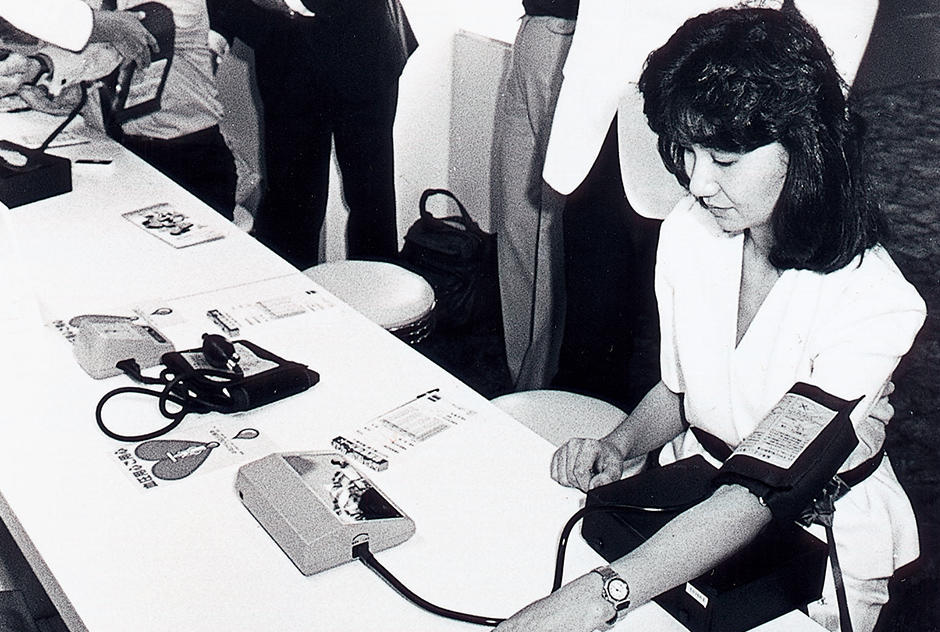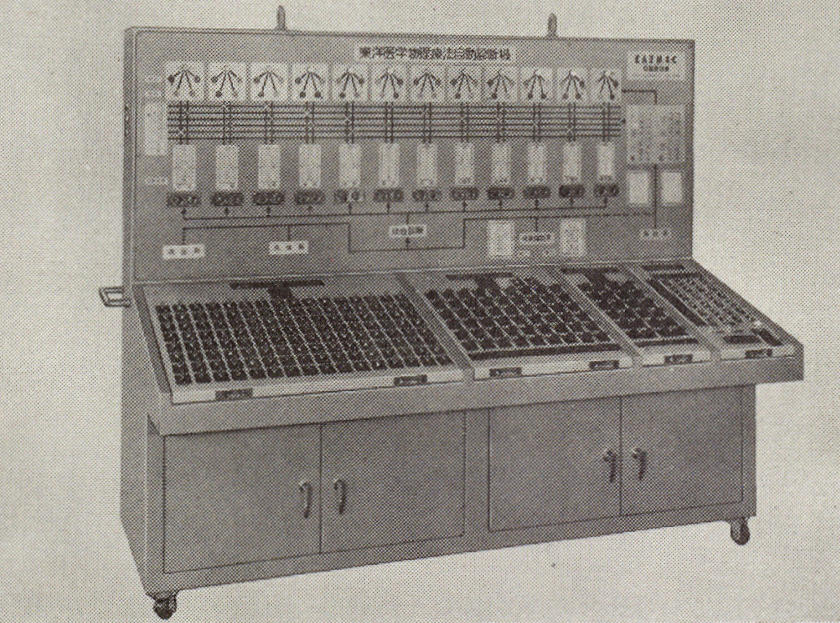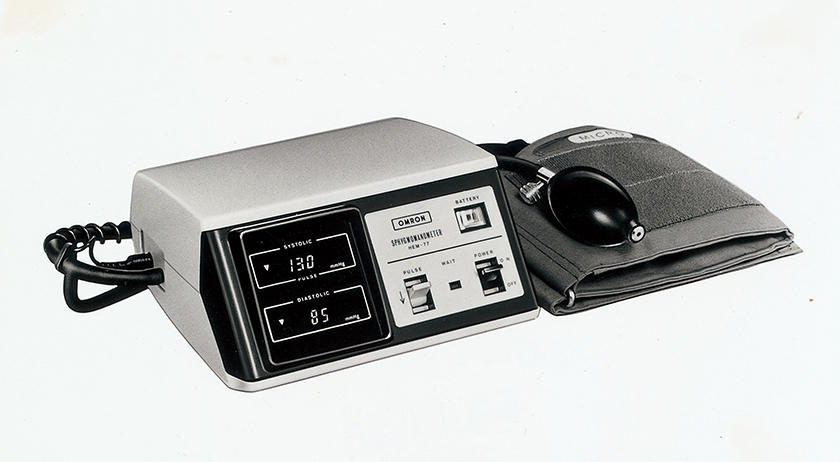
In this series of articles with 8 episodes, we trace the thoughts and speculations of OMRON's founder, Kazuma Tateishi, a rare technologically minded executive, and looks at the background to his growth and business philosophy.
In this sixth installment, we will explore how OMRON came to be widely known as a "healthcare company" as we know it today, and the hidden thoughts and visions of Kazuma. What episodes were behind OMRON's decision to venture into the completely new field of healthcare, after starting out mainly with the development of automation technology and products used in factories?
70 years ago, Kazuma Tateishi focused the importance of maintaining good health. It was triggered by the death of his wife from cancer in 1950. Every time he recalled her struggle with the disease and the surgery she had underwent, he vowed that he must live a long life without illness in order to raise his children well.
As a matter of fact, Kazuma himself was sickly and weak in his youth, and he was unsure about his health. That was the reason why he turned his attention to the "Nishi Method of Health" created by Katsuzo Nishi. It is a comprehensive health method based on the concept of "Symptom equals Goodness (Therapy)," which considers that symptoms appear when the body is trying to cure a disease. It's totally different from Western medicine which provides treatment by looking at the symptoms of the disease, based on the concept of "Symptom equals Disease ŌåÆ Treatment."
Kazuma was impressed by the concept of "finding out the cause from the symptoms and treating the cause" advocated by the Nishi Method of Health. He realized that there was a connection between health management and business management, and that the concept of "Symptom equals Goodness (Therapy)" could also be applied to business management.
What is unique to Kazuma is that he did not stop with his sensory perception, but systematized it into an engineering approach to health management. In the same way that corporate management looks ahead and implemented various measurements, Kazuma's strongest goal in health management was to prevent diseases before it occurs. He called this a "preemptive approach to diseases" and believed that it was important to "Enhancing the health conditions on a daily basis" and to "streamline and strengthen the management of health" in order to build confidence in one's health.
Thus, once the ideal goal was set, Kazuma proceeded to consider various ways to realize it.
In 1958, on the commemoration ceremony of the 25th anniversary of the company's founding, Kazuma gave a ceremonial speaking. In that speech, he touched on the company's future management policy and declared the following direction for the next 25 years.
"For the next 25 years, we need to commercialize products for the next era through new technological innovations. I believe that these products will be contactless relays and contactless switches. Another new product line is the manufacture, sale and management of machines and facilities to cure cancer, cerebral hemorrhage and diabetes, which are the biggest issues of modern people."
The content of the health-related business seemed to be a difficult project that could not be easily accomplished with the medical and pharmaceutical technology at that time. However, it was Kazuma's belief that if there were issues that modern people face, the greatest contribution to the society is to make that new challenge a success on our own. He also believed that the company already had the ability to accomplish this difficult task, thanks to the accumulated experiences and technologies developed over the past 25 years.
Health Engineering Born From the Application of Automation Technologies
In the early 1960s, Kazuma had begun to systematize his own efforts in health and proposed the world's first concept of "Health Engineering". The idea is that the human body is a tissue-engineered assembly of countless automatic control systems, and by applying automation technology to it, we can manage our health and diagnose and cure diseases. In 1961, the Central R&D Laboratory began research and development to create health medical devices based on this original theory.
Automation technology is characterized by the fact that when a machine in operation deviates from its normal state, it feeds back the measured deviation to a mechanism that automatically adjusts and corrects itself. Applying this to humans, we can think of illness as a deviation from a healthy state. In other words, in order for health engineering to work, it is important to understand the medical condition, and a means to quantify and measure the degree of illness is necessary.
As a result, the Central R&D Laboratory started researching instruments to comprehensively measure the medical condition, and as a result, a stress meter and KAZMAC(*1), an automatic diagnostic device for oriental medical physical therapy, were developed. These research and development resulted in an automatic diagnostic device for oriental medical physical therapy. This research and development led to the current hit products such as the digital blood pressure monitor.

*1: A device that scientifically analyzes data by 12 systems, such as the lungs and stomach, and displays the treatment points required for acupressure, acupuncture and moxibustion using lamps.
What Kazuma has aimed for in health engineering is to prevent illness before it occurs. To achieve this, visiting hospital is important, but also being able to monitor your medical conditions at home on a daily basis. One of these indicators is blood pressure.
Hypertension, also known as the "silent killer," needs to be detected and treated in early stage because there is a high risk of arteriosclerosis developing unknowingly, leading to severe diseases such as angina pectoris, myocardial infarction, kidney failure, cerebral hemorrhage, and cerebral thrombosis.
OMRON developed its first electronic blood pressure monitor "Manometer-typed Manual Blood Pressure Monitor (HEM-1)" in 1973, and completed its first digital blood pressure monitor "Digital Blood Pressure Monitor for Home Use (HEM-77)" in 1978. OMRON has been working with medical professionals to promote home blood pressure monitoring and has created a culture of "measuring blood pressure at home." Today, OMRON has the largest share of the global market for home blood pressure monitors.
In 2015, OMRON proposed "Going for Zero " as its business vision, aiming to reduce the incidence of cerebral and cardiovascular diseases to zero, and provides devices and services useful for the treatment and prevention of hypertension globally. To achieve this mission, we have successfully developed the world's first wearable blood pressure monitor that has been certified as a medical device in the U.S. and Japan.
All of these achievements are the fruit of the preventive medicine concept at the core of health engineering advocated by Kazuma. OMRON will continue to contribute to help realize the healthy and comfortable lives for people around the world through measurement technologies applying health engineering, based on its corporate philosophy that "business should create value for society through its key practices."

In the next 7th episode, we will introduce the "Big Business Syndrome" advocated in 1981 by Kazuma, who became the chairman of the company, and how he demonstrated the entrepreneurial spirit to overcome it.